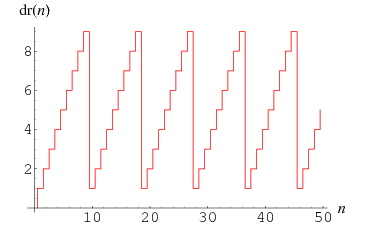
Digital Root
 المؤلف:
Sloane, N. J. A.
المؤلف:
Sloane, N. J. A.
 المصدر:
Sequences A007612/M1114 and A010888 in "The On-Line Encyclopedia of Integer Sequences."
المصدر:
Sequences A007612/M1114 and A010888 in "The On-Line Encyclopedia of Integer Sequences."
 الجزء والصفحة:
...
الجزء والصفحة:
...
 11-11-2020
11-11-2020
 1382
1382
Digital Root
Consider the process of taking a number, taking its digit sum, then adding the digits of numbers derived from it, etc., until the remaining number has only one digit. The number of additions required to obtain a single digit from a number  in a given base is called the additive persistence of
in a given base is called the additive persistence of  , and the digit obtained is called the digital root of
, and the digit obtained is called the digital root of  .
.

For example, the sequence obtained from the starting number 9876 in base 10 is (9876, 30, 3), so 9876 has an additive persistence of 2 and a digital root of 3. The base-10 digital roots of the first few integers are 1, 2, 3, 4, 5, 6, 7, 8, 9, 1, 2, 3, 4, 5, 6, 7, 8, 9, 1, ... (OEIS A010888). The digital root  of an integer
of an integer  can be computed without actually performing the iteration using the simple congruence formula
can be computed without actually performing the iteration using the simple congruence formula
REFERENCES:
Sloane, N. J. A. Sequences A007612/M1114 and A010888 in "The On-Line Encyclopedia of Integer Sequences."
Trott, M. The Mathematica GuideBook for Programming. New York: Springer-Verlag, p. 28, 2004. https://www.mathematicaguidebooks.org/.
 الاكثر قراءة في نظرية الاعداد
الاكثر قراءة في نظرية الاعداد
 اخر الاخبار
اخر الاخبار
اخبار العتبة العباسية المقدسة


